|
|
 |
|
Bernini's work at St. Peter's |
|
written
by juliatm / 09.28.2004 |
|
|
|
Bernini's Projects |
| |
Statue of Constantine |
| |
| |
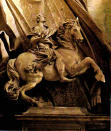
|
|
| Equestrian Statue of Constantine the Great |
| In this statue designed by Bernini, Constantine is capture at the moment of his spiritual conversion and is riding his horse without stirrups or reigns. |
| |
|
On the wall opposite the main doors at the extreme right of the atrium is Bernini’s equestrian statue of Constantine, constructed between 1662 and 1668. Constantine is portrayed at the instant that led to his ultimate conversion, after his vision of “In Hoc Signo Vinces” (or, “By This Sign Though Shalt Conquer”) encircling a cross, and before subsequent victory at the Battle of the Milvian Bridge on the Tiber in 312 AD. Ten years after this victorious battle, Constantine, the first Christian emperor, began his initial construction of the original St. Peter’s. This statue of Bernini's employs the Baroque idea of a charged space, of capturing a given moment; both horse and rider are gazing up at the cross above, responding to the image they see. The horseman's clothes are blowing in the wind, set against a backdrop of drapery that is seemingly filled with movement. Constantine's horse is on its hind legs, with the hair of its mane and tail exaggerated. This concept of theatricality, of flowing movement arrested at a single point in time, is one that is entirely of the Baroque era. It has been said that the finished statue was so unwieldy and large that a door of Bernini's studio had to be torn down in order to remove it.
|
| |
|
| |
|
| |
Bas Relief on Main Portal |
| |
High above the main doors to the church is a bas-relief designed by Bernini with the words Pasce Oves Meas, or “Feed My Sheep.” Depicted in the relief is an image of Christ confronting the kneeling Peter, and gesturing towards His “sheep” – that is, Christ’s people for Peter to care. This refers back to a biblical passage in the book of John where Christ instructs the apostle Peter to look out for members of His flock. Implied in Bernini's bas-relief is the Catholic belief that papal authority was a divinely ordained responsibility, and that the pope could be traced back through unbroken succession to Saint Peter, and to Christ himself. This symbolism and idea of heavenly authority, as well as the emphasis on firmly establishing authority itself, is one that is repeated throughout the entire church.
|
| |
|
| |
|
| |
Tomb Monument to Countess Matilda |
| |
| |
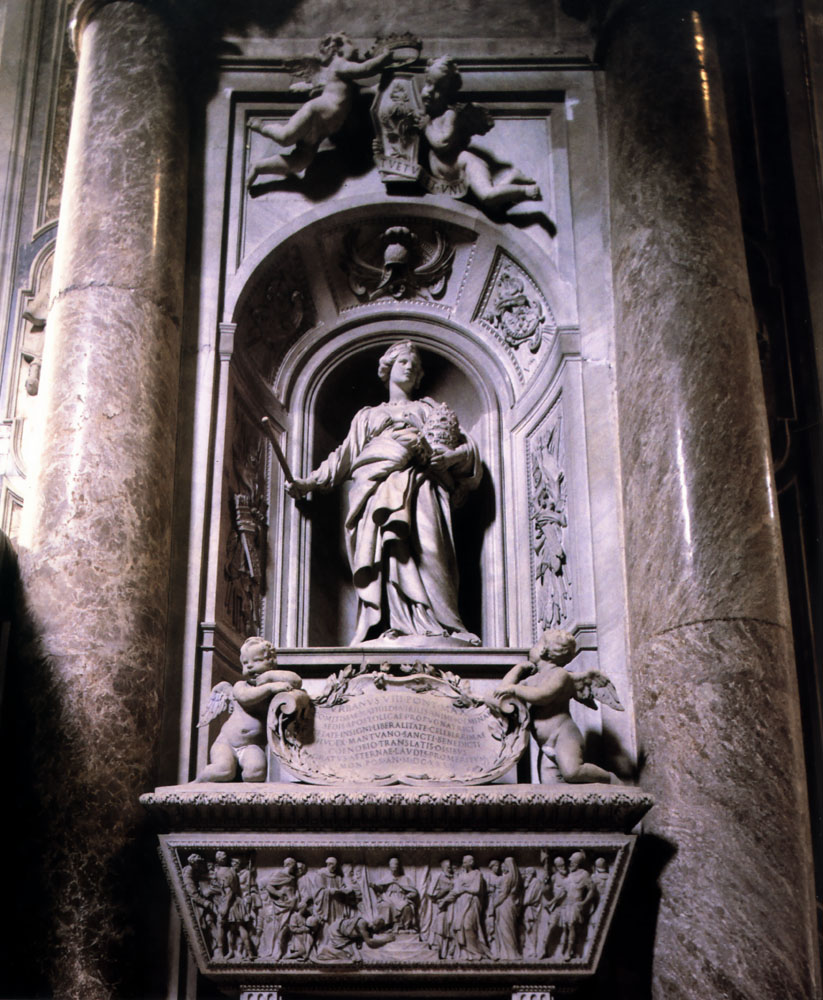
|
|
| Tomb-monument of Countess Matilda |
| Monumental tomb of the countess with a depiction of the "Submission of the emperor Henry IV to Pope Gregory VII" |
| |
|
| |

|
|
| Front of sarcophagus |
| Bas-relief depicting the "Submission of the emperor Henry IV to Pope Gregory VII" at Canossa. |
| |
|
Inside the church, on the second pier of the right aisle, is a tomb-monument of Countess Matilda of Tuscany. Designed by Bernini, the work was commissioned by Pope Urban VIII in 1633, who wished to venerate one of the most powerful women in the Middle Ages. Countess Matilda was an 11th century noble-woman who owned large amounts of property in Northern Italy. Upon her death, she bequeathed these vast estates to the Holy See. It is logical that Urban VIII would have wanted to call attention to this action given the much-diminished secular power of Rome, and by commissioning a tomb-monument to be created and placed in the Vatican basilica, he set the woman as an example by which he desired contemporary princes to follow.
This element of propaganda is further obvious in the front of the sarcophagus. Here there is an image depicting a scene that took place in 1077, with Holy Roman Emperor Henry IV - who ruled Germany, Italy, and Burgundy - kneeling and humbling himself before Pope Gregory VII in front of Matilda's castle in Canossa. This is significant in that it represents the highest peak of papal supremacy in international affairs. It is important to recognize why Pope Urban VIII would want to refer back to the glorious days of ultimate authority of the pope.
|
| |
|
| |
|
| |
Chapel of the Blessed Sacrament |
| |
| |
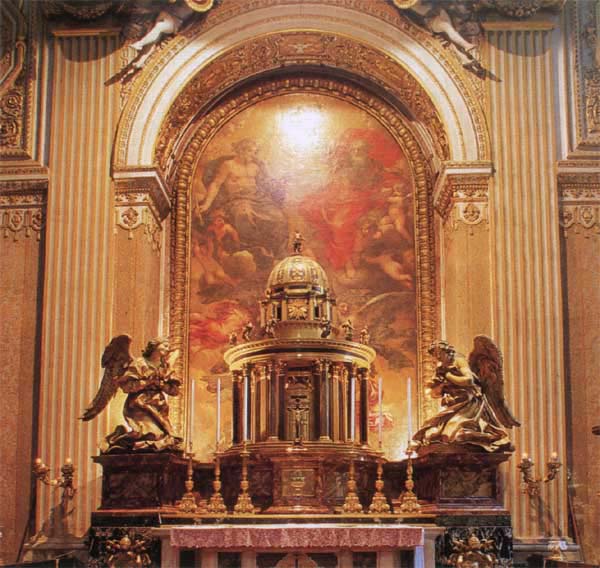
|
|
| Chapel of the Blessed Sacrament |
| Bernini's tabernacle inside the Holy Sacrament - "Only those who pray may enter." |
| |
|
The Capella del Santissimo Sacramento (Chapel of the Blessed Sacrament) was constructed in 1973-74, and was one of Bernini's last works. His preliminary sketches for the altar design involved rings of angels holding up the 'tabernacle for consecrated wafers of the sacrament' with the mere touch of their fingers. In the end, however, Bernini chose a much less elaborate design, with the tabernacle resting on a firm base and a bronze angel on either side. The angel on the left has her eyes closed, and is in complete adoration. In contrast, the one on the right has her eyes open and is gazing at the viewer, inviting him/her to participate in the action at hand. This is an artistic technique that was used often by Bernini and other Baroque artists, where one figure is completely involved in the depicted scene, while another invites the audience to take part in what is going on within the work itself.
|
| |
|
| |
|
| |
Baldachino and Transcept of the Basilica |
| |
| |
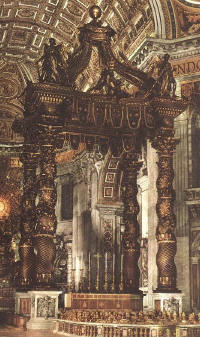
|
|
| Baldachino |
| Bernini's first big commission, the Baldacchino, rises about ninety-five feet - the equivalent of an eight-story building. |
| |
|
| |
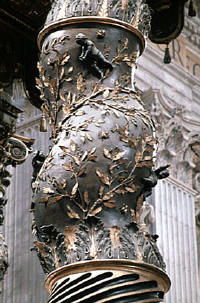
|
|
| Solomonic Columns |
| Bernini's use of twisted columns gives reference to Jerusalem and establishes the baldachino and transcept as Jerusalem itself. |
| |
|
| |
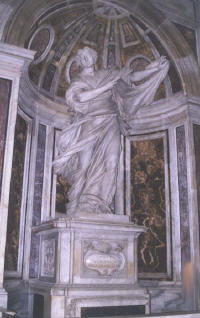
|
|
| St. Veronica |
| Statue of St. Veronica with kerchief used to wipe the sweat from Christ's face. Sculpted by Francesco Mochi. |
| |
|
| |

|
|
| St. Helena |
| Statue of St. Helena with fragment of the True Cross she discovered in the Holy Land. Sculpted by Andrea Bolgi. |
| |
|
| |

|
|
| St. Andrew |
| Statue of St. Andrew with Greek cross on which he was martyred. Sculpted by François Duquesnoy |
| |
|
| |
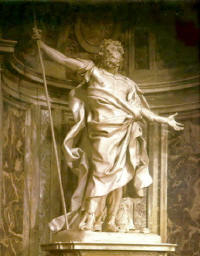
|
|
| St. Longinus |
| St. Longinus holding the lance with which he pierced Christi's side. Sculpted by Gian Lorenzo Bernini. |
| |
|
Baldachino comes from the Italian word "baldacco", which refers to a silk cloth that was used to make canopies above important places and people. In Bernini's bronze canopy, he employs twisted marble columns called "solomonicas" which were thought to have come from Solomon's Temple. Bernini adopted the style for his baldachino because Constantine used them in his original church, and several of the first columns are still preserved in the modern-day basilica.
In working on the baldachino, Bernini was aided by his father and numerous other sculptors and craftsmen. Finding enormous quantities of bronze necessary to construct the columns was an overwhelming task, and part of the bronze used was plundered from the roof of the porch of the Pantheon - lending to the often quoted phrase, "What the barbarians didn't do, was done by the Barberini."
Digging the foundations for the enormous shafts required to support the columns - each 10 feet square and 14 feet deep - proved to be a difficult problem. Bernini himself proclaimed that "the work came out well by luck," as any slight error in the building of the structure would have proven to be disastrous. The finished baldachino was unveiled on June 29, 1633 at the Fest of St. Peter. It served not only as a canopy, sanctuary, and visual framework for St. Peter's chair (which will be discussed later), but symbolically mediated between heaven and earth - identical to the function of the church.
If we recall Bernini's choice of twisted solomonic columns and recognize that, in his time, these columns would have invoked images of Jerusalem itself, then it is of utmost significance that Jerusalem was the site of Christ's crucifixion, resurrection, and ascent to heaven. This is because, through elements within the crossing of the church (at the intersection of the nave and transepts where the baldachin rises beneath the dome), the baldachin is established as Jerusalem. Bernini himself suggested the altar below the baldachino represented the Crucifixion, the triumphant cross above signified the Resurrection, and Michelangelo's dome at the top was symbolic of Christ's ascent to heaven. In addition to this, Bernini also pointed out the triple nature of Christian divinity that was embodied in the form of a great dove underneath the canopy (Holy Ghost), cross above the baldachino (Christ the Son), and mosaic by Cesari d'Arpino in the summit of the dome (God the Father).
While working on the canopy structure, Bernini was commissioned to assemble four prized relics with four figures of saints associated with these relics in the four surrounding niches supporting the dome. The first of these relics, now regarded as more symbolic than authentic, is the kerchief St. Veronica used to wipe the perspiration from Christ's face as He carried the Cross to Calvary. It is said that the impression of Christ's face was miraculously imprinted on the kerchief. The second relic is the fragment of the True Cross, brought to Rome from the Holy Land by St. Helena, Constantine's mother. Thirdly, the skull of St. Andrew (St. Peter's brother) who was thought to be martyred in Greece on an X-shaped cross was once acquired by the church, but was brought back to Greece in 1964 by Pope Paul VI. Lastly, there is the relic of the lance of St. Longinus, the Roman centurion who stabbed Christ's side, only to realize Christ's divinity after inflicting this fatal wound.
Each of the four saints faces the awe-inspiring baldachino, and the figures stand below balconies that contain angels in their bas-reliefs, balconies which serve as displays for the three remaining relics that are brought out on Easter and Good Friday. Of there four sculptures, only St. Longinus was carved by Bernini (the other three were done by Bernini's assistants). This 14.5-foot tall statue constructed between 1635 and 1638 was one of Bernini's largest, and the artist made at least twenty-two models in preparation for it. Important to note are St. Longinus' outstretched limbs - his arms and legs are elongated and spread out, and artistic technique that would not have even been considered in the Renaissance time. The idea of "knowing how to draw a straight line but choosing to draw a curve instead", of breaking out of a single block in thought, was inherently Baroque in nature.
|
| |
|
| |
|
| |
St. Peter's Chair or Cathedra Petri |
| |
| |
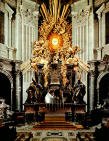
|
|
| Cathedra Petri |
| Saint Peter's chair, surrounded by saints and illuminated by glorious oculus above. |
| |
|
| |

|
|
| Oculus surrounded by angels and cherubs |
| Glory above chair that allows light to pour into the basilica contains a dove at center that is representative of the Holy Spirit. |
| |
|
Bernini's vision for the Cathedra Petri, or Chair of St. Peter's, included that it be visible from the entrance of the church at the end of the 600 foot nave, framed by the baldachin columns with rays of sunlight streaming down the central aisle along the east-west axis. The bronze chair, completed in 1666, encases the wooden one that was supposedly used by St. Peter himself. One of the church's most venerable relics, the throne has been in both the old and new St. Peter's for many centuries. Recent tests, however, have dated the wood from the chair to the 9th century AD, and studies have established that the chair was donated by Charles the Bald on his coronation in 975. Nonetheless, great prominence is appropriated to this treasured reliquary; the chair is placed in the exact center of the main apse and seems to float above the altar.
Surrounding the chair, at each of the four legs, are four saints that contribute to the spectacular Baroque setting. In the foreground are giant statues of St. Augustine and St. Ambrose, their robes appearing to be blown in the wind, representing the Latin branch of the Catholic Church. Situated at the background are statues of St. Athanasius and St. Chrysostom, signifying the Greek branch of the Catholic Church. The four saints in the background and foreground have their fingertips linked to the Chair by loops of drapery and are interpreted as being in communion with the chair, as opposed to supporting the chair itself. This is a crucial distinction, as the chair supports itself, significant when taking into consideration the attitude of the Church as being self-sustaining.
Above the chair is an oculus encircled by angels and cherubs through which light floods in. The dove of the Holy Spirit is illuminated at the center, and here light itself becomes a structural element - similar to the way in which Bernini uses water in his magnificent fountains.
|
| |
|
| |
|
| |
Tomb of Alexander VII |
| |
| |
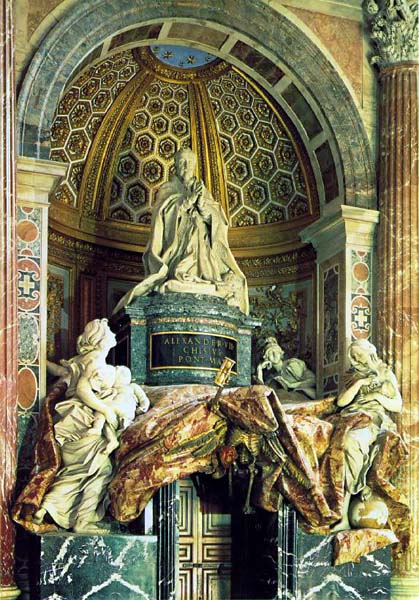
|
|
| Tomb-monument of Alexander VII |
| One of Bernini's last works, the statue of Alexander VII is surrounded with figures of Prudence (left rear), Charity (left front), Truth (right front), and Justice (right rear). |
| |
|
Across the left wall, diagonal from St. Longinus is the tomb of Alexander VII, completed in 1979 after seven years when Bernini was eighty years old. According to Baldinucci, one of Bernini's biographers, Bernini undertook this commission "on account of his gratitude to the memory of the prince...notwithstanding his age and the decline of his strength which made him daily less capable of such work." Small parts of the monument were carved by Bernini (including Alexander's face and hands), but it can be certain that the entire work was under his rigid control and direction.
One major disadvantage that would have discouraged many an artist was the large niche in which the tomb monument was to be placed - the niche contained a doorway in the center of the rear wall. Bernini, however, used this obstacle as an asset, and used the door to represent a tomb entrance. Death was often represented as a skeleton holding an hour glass for the living, indicating time's passage. Bernini was the first to utilize three-dimensional skeletons, and this idea might have originated from a memorable mass conducted at Il Gesu (the Jesuit church Bernini attended during much of his adult life) in 1639. In this unusual service, Jesuit fathers constructed mechanical skeletons - some holding swords and crowns to symbolize the dominance of death over this present world, others grasping Adam and Eve after their initial sin of consuming the forbidden fruit. These figures from the memorable mass may have left an impression upon Bernini's mind. as Alexander's tomb monument involves a similar 3-D skeleton, emerging from the symbolic tomb.
Surrounding Alexander VII's tomb are four allegorical figures: Prudence, Charity, Truth, and Justice. This imagery is noteworthy when keeping in mind the desired impact the patron (Alexander VII) intended the viewer to have. That is, the fact that Pope Alexander VII is surrounded by virtues and is carved in a kneeling position makes him appear quite pious. Alexander's successor, Pope Innocent XI, had a severe view towards nudity, and forced Bernini's statue of Truth to be covered up with a bronze cloth and painted white.
|
| |
|
| |
|
| |
Tomb of Urban VIII |
| |
| |
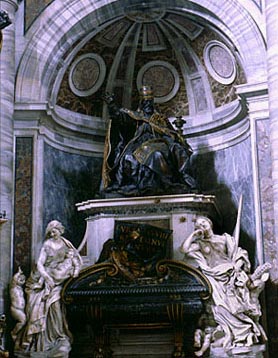
|
|
| The monument of Urban VIII |
| Bernini's funeral monument to his beloved patron. |
| |
|
The tomb of Bernini's beloved patron, Urban VIII was commissioned in 1628 (by Urban himself), almost twenty years before his death. The funerary monument holds many resemblances to that of Alexander VII, including a giant sarcophagus forming the base for a bronze figure of the pope, with allegorical figures on either side. Here, there are two white marble figures that represent Justice (on the right) and Charity (on the left). On top of the sarcophagus is the Genius of Death writing the name of the Pontiff on an unrolled piece of parchment. In usual Bernini fashion, there is much theatricality to the work, and Urban VIII's tomb remained the most important model for papal tombs until the end of the Baroque era.
|
| |
|
| |
|
| |
Colonnade and Piazza |
| |
| |

|
|
| St. Peter's Piazza |
| St. Peter's Piazza, with Colonnade connected by corridors to facade of basilica. |
| |
|
| |
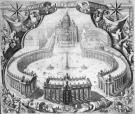
|
|
| Original Colonnade Plan |
| Bernini's transverse oval plan - including a 'third arm' - tactfully credited to the pope (Alexander VII). |
| |
|
Commissioned by Alexander VII in the summer of 1656, Bernini's Colonnade may very well constitute the most successful architectural work known to mankind. Taking into consideration all barriers Bernini had to work around, St. Peter's Piazza is yet another example of Bernini's skill and creative perfection. Entering St. Peter's Piazza, the pilgrim is confronted with a "symbolic heaven", with 96 of Bernini's saints and martyrs situated above individual travestine columns. The viewer is enveloped by the spaciousness, yet is not overwhelmed. Bernini described his Colonnade as the arms of the Mother Church "stretching out to receive Catholics, so as to confirm them in their faith, heretics to reunite them with the Church, and infidels to enlighten them in the true faith."
In designing the Colonnade, visibility was of a major concern. The transverse oval design provided maximum amount of unobstructed views of the windows from which the pope gave his blessings urbi et orbi (to the city and the world). One of these windows was of the Benediction Loggia above the portico of St. Peter's (from which the pope gave his blessing on Easter and other special days), the other one (for other occasions) was in the papal apartment high in the Vatican palace to the north. By swinging the colonnade as far toward the papal apartment as possible and providing a longer horizontal axis, the visibility factor was dealt with.
In order to compensate for the wide facade of St. Peter's Basilica, Bernini "made it appear taller by contrast" by constructing relatively low (39 foot) columns. He also connected the curved colonnades to the basilica by a pair of straight, enclosed corridors of the same style and height in order to provide a further optical "pinching" effect of the broad facade.
And the obstacles don't stop there. The colonnades all reach 39 feet, but each of the columns varies in level of foundation, as the ground slopes down away from the basilica. The individual statues of saints and martyrs atop the columns were designed by Bernini but executed by many sculptors, with Lazzaro Morelli carving 47 of the 96 saints. Each of the 15 foot tall saints piece together to constitute a whole, creating an outdoor "pantheon" (if you will) of Catholic saints to welcome approaching pilgrims on their journey.
Originally, the piazza was to be enclosed by a "terzio baccio", or "third arm." Bernini later decided to place this back and allow for an entrance court - a "theatrum mundi" (world theater) resembling the ancient ampitheaters such as the Colosseum. This third arm was never built, but Bernini still successfully displays a construction that is both open and closed, a "teatro" that recalls the greatness of Ancient Rome.
|
| |
|
| |
|
|
 |
|
















